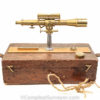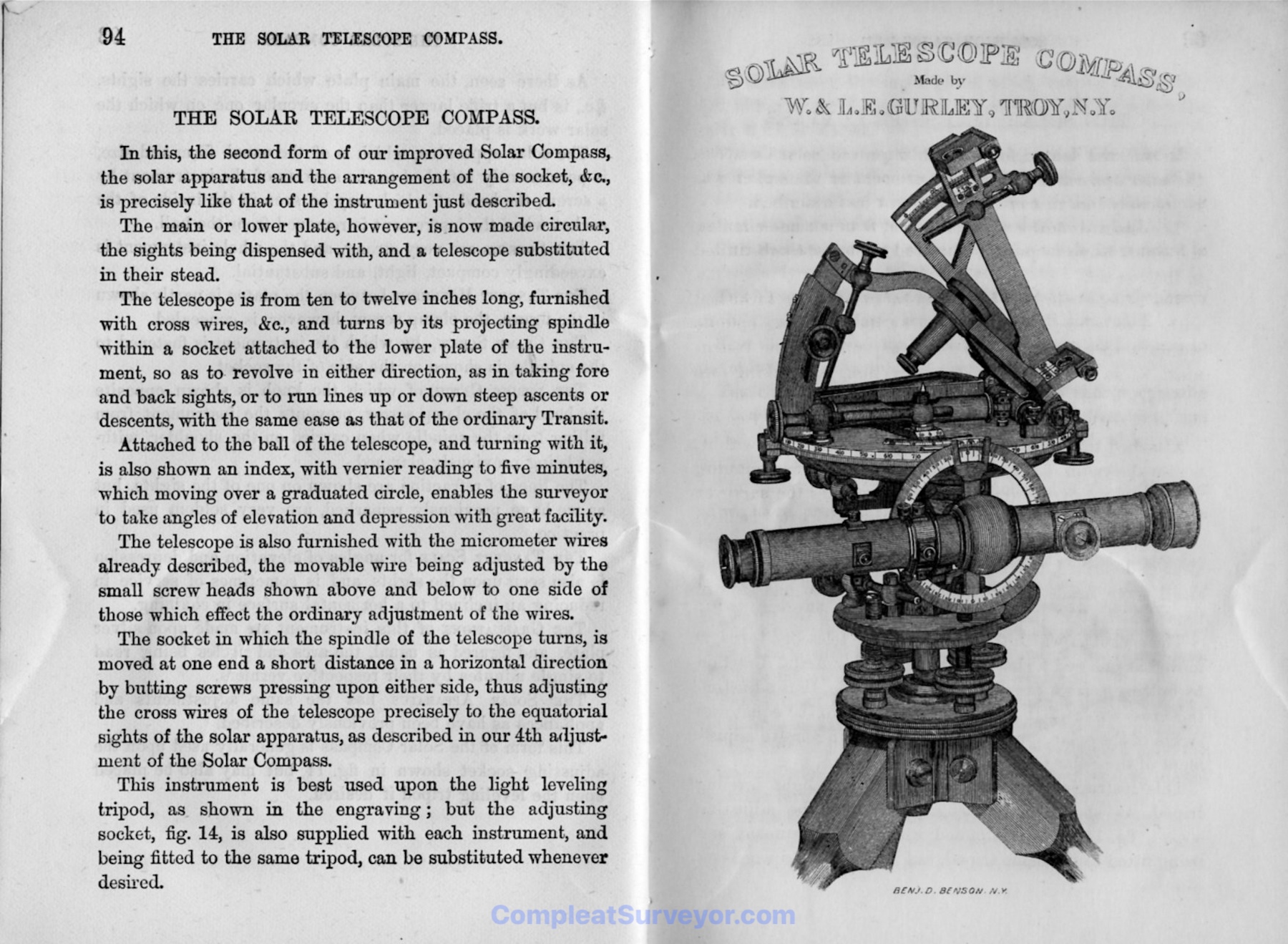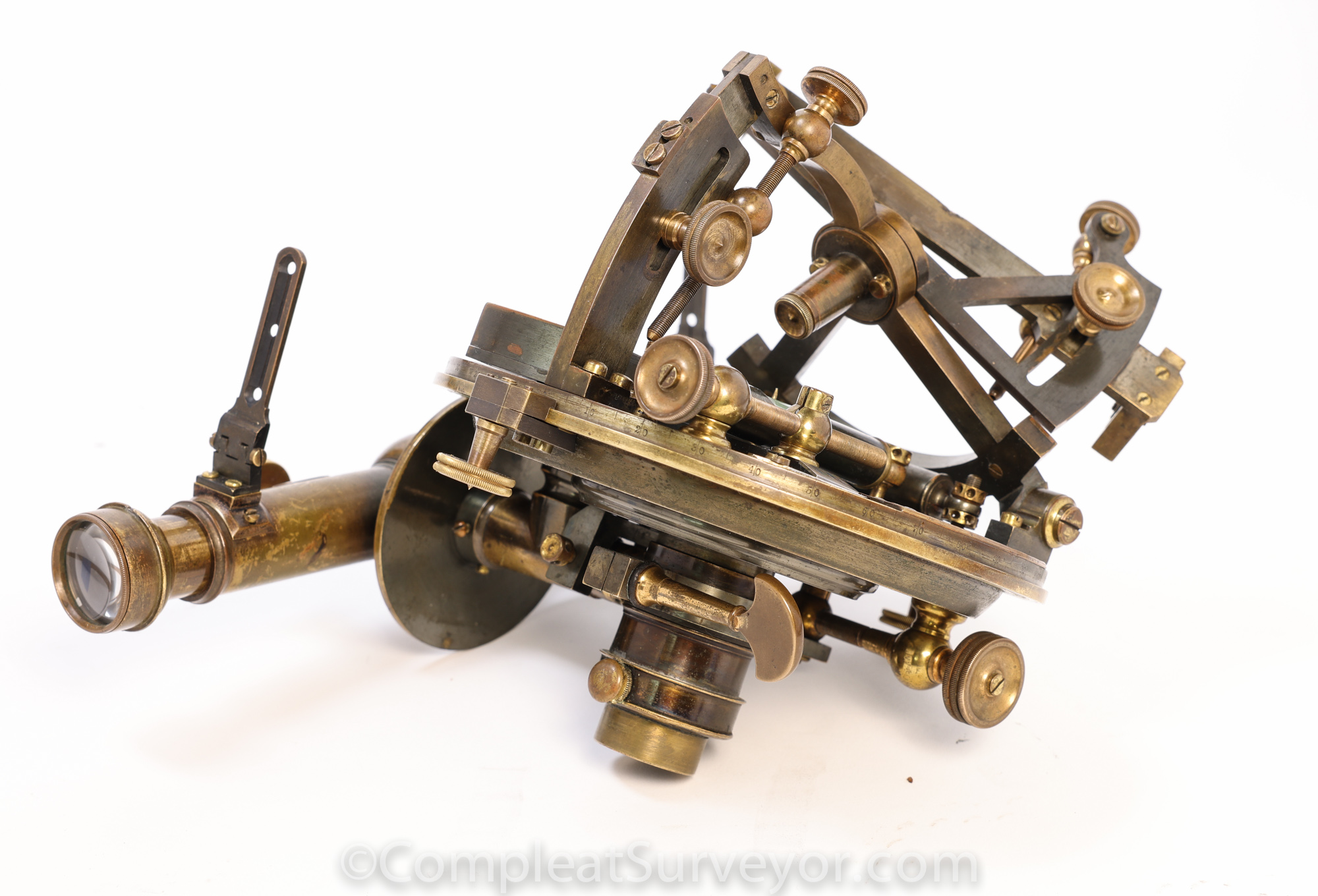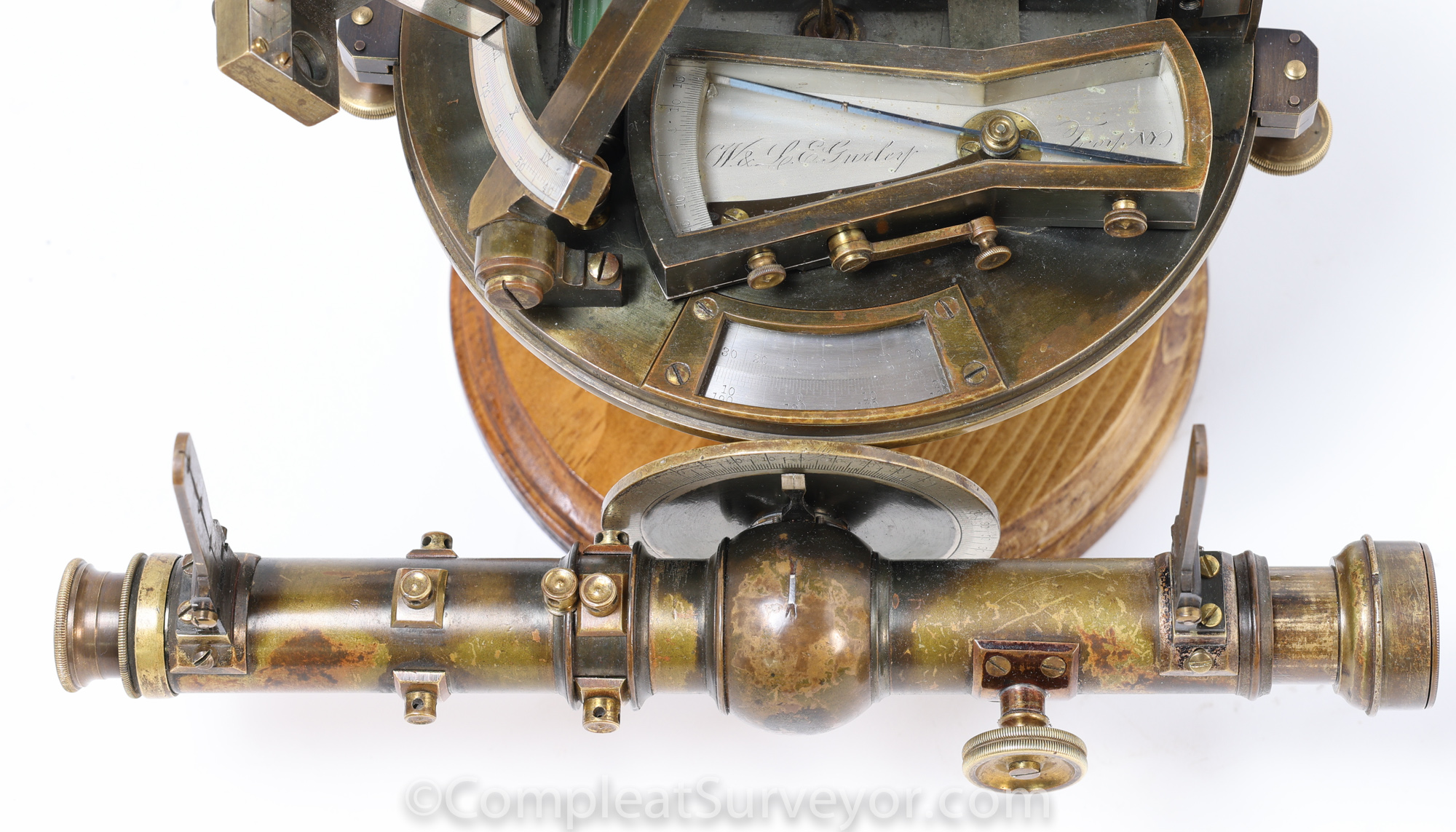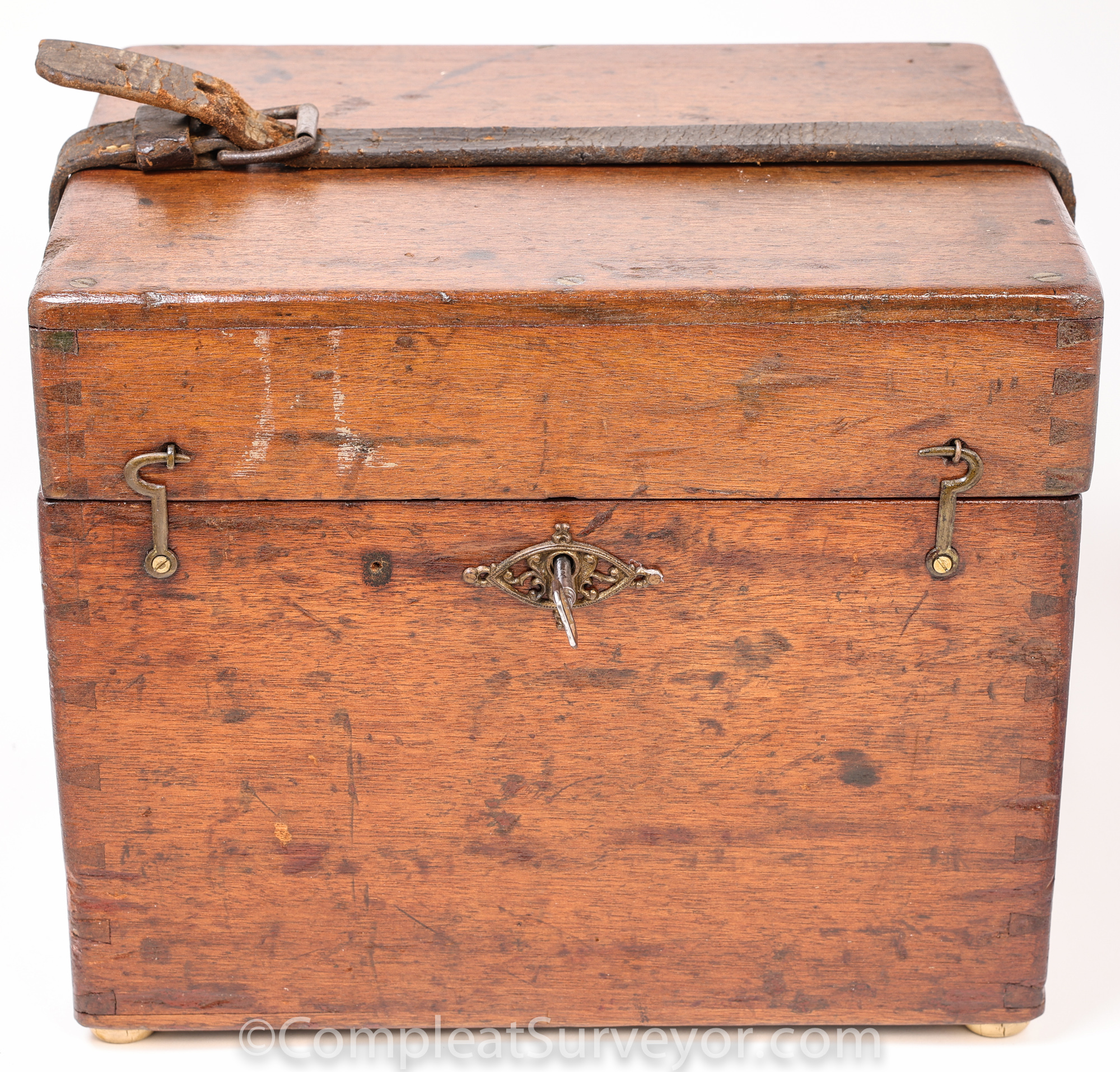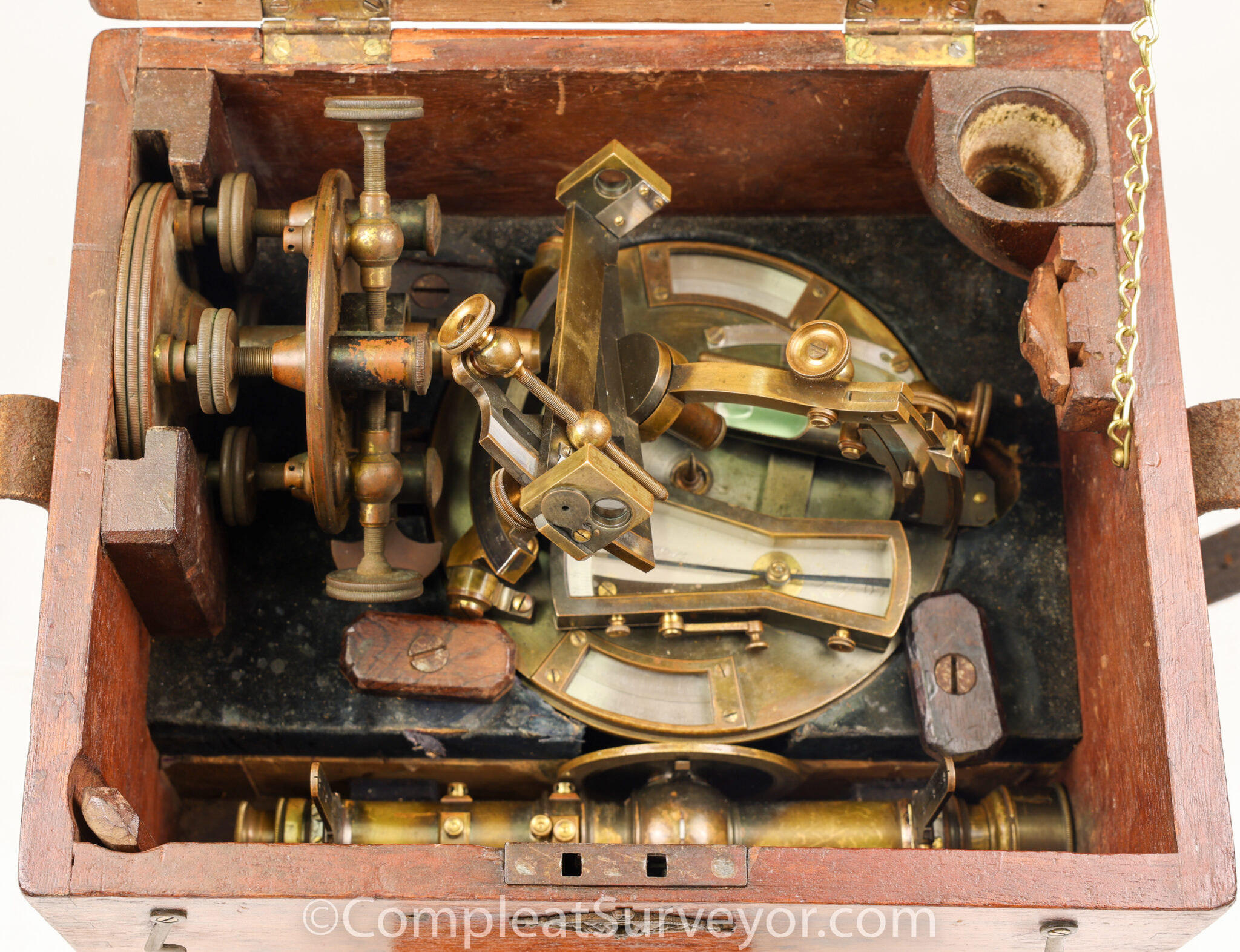Description
This is the only privately-owned Gurley Solar Telescope Compass (STC) known. For the reasons discussed below, the STC offered here should be a Top of The Bucket List item, and it is very unlikely that you will ever see another one offered for sale.
Rarity
Gurley apparently did not sell many STCs. Gurley started offering STCs for sale in its 1858 Catalogue, sold very few instruments of any kind during the Civil War Years (1861 to 1865), and then stopped selling the STC in 1870 or 1871 (based on statements made in the Gurley 1873 Catalogue).
Adding a telescope to a solar compass was a wonderful idea. Gurley invented a telescope that mounted on a sight vane in the late 1870s, and sold a good number of these auxiliary telescopes to owners of solar compasses.
A side mounted telescope that could measure vertical angles no doubt seemed like a winner in 1858. The telescope allowed for longer sightings, while eliminating the sight vanes and supporting arms saved both size and weight. The side mounted scope had two shortcomings, however. First, the surveyor would have to take the offset nature of the telescope into account each time the surveyor measured an angle – Gurley provide instruction in its catalogues regarding that. Second, the side mounted telescope tended to unbalance the instrument. This was a fatal flaw. Surveyors objected to the unbalanced nature of the STC, which apparently reduced the demand for the instrument enough so that the STC was no longer commercially viable.
(You can read Gurley’s 1873 statement about discontinuing the STC a few years before here).
The bottom line…Gurley sold very few STC’s, and only two Gurley STC’s are known to have survived. I understand that the other known STC is a very nice instrument as well and is held by a historical society. I also understand but have not confirmed that it has a replacement telescope.
Provenance
This STC is blessed with two known owners: William H Byars and Byron B. Herrick Jr.
Byars named appears twice on box lid – once stamped on a Roach label, and again on a label for the newspaper that Byars published. Roach apparently worked on this instrument in 1879 (see pic of showing Roach and an 1879 date). So Byars stated the Roach label in 1879 or thereafter. Byars sold the newspaper in 1882 or so. So it’s clear that Byars owned the STC after 1879 and before 1882.
I believe but don’t know for sure that William Byars was actually the original owner of this STC. Byars started his surveying career in 1869 or 1870, while the STC offered for sale here was made in April 1869 (see pic below showing the name of the Gurley engraver with the date April 1869). So the timing lines up for Byars to be the original owner.
I also believe that Byars sold the STC to Byron Herrick in 1892 (see pic showing Herrick’s 1892 engraving). Byars became the Surveyor General in Oregon in 1892, so his days of hands-on surveying were pretty much over. So Byars owning the STC until 1892 makes sense as well.
Byars was a fairly well-known fellow in Oregon. He had some incredible adventures during his younger days, and owned a number of newspapers over his lifetime.
Byron B. Herrick was the next owner. He surveyed on a crew with William F Byars (the son of the owner of this STC, William H. Byars) in 1891, and then purchased the STC from William H Byars in June 1892. Herrick was elected Marion County Surveyor right before then, a position that Byron apparently held for 42 years. Byron also served as a special examiner of surveys in 1893-1894.
Condition
This STC took a fairly hard knock at some point. I had the STC professionally repaired, and it looks and works great. You will not be disappointed in the quality and condition of this instrument. You really should look at the 360 Degree Spinner View – With ZOOM View to appreciate this instrument fully.
Worth noting…the STC did not have the two horizontal plate clamps when I picked it up. If you look thru some old Gurley Catalogues, you will see an illustration of an earlier style STC that did not have the plate clamps. Other illustrations show the plate clamps, however, as the pic attached below demonstrates. I concluded that this STC originally had the plate clamps because (1) the bottom plate had drill holes where the clamps went and (2) the storage box has carve outs for the clamps. So I had my professional repair guy make two clamps for this STC. I think the clamps look great, and blend in nicely with the instrument.
Also worth noting – The telescope originally came with stadia wires. My repair guy says that the wires wouldn’t last long on the telescope given the amount of vibration that the side mounted telescope endures. So the telescope has crosshairs but no stadia wires. The telescope is also very delicately balanced – it takes very little effort to rotate the scope. Having the front end of the scope extended (as shown in my pics) helps keep the scope horizontal.
The tripod and leveling base are not original to this STC. There is a note on old paper in the box saying that the tripod is in the closet. But after some looking, I found a correct tripod and leveling base for this STC. According to the Gurley Manuals, a purchaser could opt for a Gurley Surveyors’ Transit tripod and leveling base for the STC. Byars apparently opted for this setup based on the configuration of the box. Gurley changed the Surveyors leveling base and tripod in 1876 or so – starting in 1876 the leveling base would screw around the outside out of the tripod mount. Prior to 1876 the leveling base would screw inside of the tripod mount. So I found a pre-1876 leveling base and tripod for this STC. Importantly, the leveling base fits inside the box PERFECTLY – the wear patterns inside the box match the leveling head. See the pics below.
Concluding Thoughts
I love this solar compass. I’ve has some pretty special solar compasses over the last 25 years, including the first Young Solar Compass made (1840), an aluminum Gurley solar compass, and the 1854 Burt & Bailey Yosemite Solar Compass. I’ve also sold about 15 solar compasses over during that time. But this Gurley Solar Telescope Compass is my favorite one. I love the look of the side mounted telescope. And the rarity of the instrument makes that look very special, and perhaps irreplaceable.
So I think this is a very unique opportunity to own one of the coolest surveying instruments made in America.
Ask the Dealer
Dealer information
 The Compleat Surveyor
The Compleat Surveyor
The Compleat Surveyor specializes in rare instruments and books related to land surveying. This initially was a family business - my father (F. D. Uzes) was a noted surveyor, collector and author (Illustrated Price Guide To Antique Surveying Instruments and Books - published in 1980). Having spent a lifetime surrounded by old instruments and books, I now run the business myself. I use my website (www.CompleatSurveyor.com) to both sell instruments and provide historical information related to land surveying.
Other items See all
-
 Wonderful and Rare Circa 1895 Gurley Engineers Solar Transit
Wonderful and Rare Circa 1895 Gurley Engineers Solar Transit$3000 (Postpaid in the U.S. - International Extra)Sold -
 Ainsworth Solar Transit – S/N 2946 – Nice Condition – Circa 1915 ***Price Drop*** $1400
Ainsworth Solar Transit – S/N 2946 – Nice Condition – Circa 1915 ***Price Drop*** $1400 -
 Black Friday Sale – Dudley Adams Mini Theodolite – Circa 1800 Black Friday Sale Price - $700 (Postpaid in the U.S.)
Black Friday Sale – Dudley Adams Mini Theodolite – Circa 1800 Black Friday Sale Price - $700 (Postpaid in the U.S.) -
